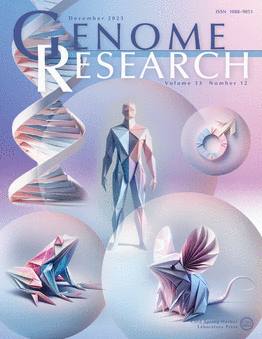Strong bias in long-read sequencing prevents assembly of Drosophila melanogaster Y-linked genes
IF 5.5
2区 生物学
Q1 BIOCHEMISTRY & MOLECULAR BIOLOGY
引用次数: 0
Abstract
Oxford Nanopore Technologies (ONT) and Pacific Biosciences (PacBio) are generally considered free from sequence composition bias, a key factor - alongside read length - that explains their success in producing high quality genome assemblies. Indeed, there had been very few reports of bias, the clearest one against GA-rich repeats in the human genome. However, our study reveals a systematic failure of both technologies to sequence and assemble specific exons of Drosophila melanogaster genes, indicating an overlooked limitation. Namely, multiple Y-linked exons are nearly or completely absent from raw reads produced by deep sequencing with state-of-the-art ONT (10.4 flow cells, 200× coverage) and PacBio (HiFi 50×). The same exons are accurately assembled using Illumina 67× coverage. We found that these missing exons are consistently located near simple satellite sequences, where sequencing fails at multiple levels: read initiation (very few reads start within satellite regions), read elongation (satellite-containing reads are shorter on average), and base-calling (quality scores drop as sequencing enters a satellite sequence). These findings challenge the assumption that long-read technologies are unbiased and reveal a critical barrier to assembling sequences near repetitive regions. As large-scale sequencing projects move towards telomere-to-telomere assemblies in a wide range of organisms, recognizing and addressing these biases will be important to achieving truly complete and accurate genomes. Additionally, the underrepresented Y-linked exons provides a valuable benchmark for refining those sequencing technologies while improving the assembly of the highly heterochromatic and often neglected Drosophila Y Chromosome.长读测序的强烈偏见阻止了果蝇y连锁基因的组装
牛津纳米孔技术公司(ONT)和太平洋生物科学公司(PacBio)通常被认为没有序列组成偏差,这是一个关键因素——除了读取长度——解释了它们成功生产高质量基因组组装的原因。事实上,很少有偏见的报道,最明显的是反对人类基因组中富含ga的重复序列。然而,我们的研究揭示了这两种技术在对黑腹果蝇基因的特定外显子进行测序和组装方面的系统性失败,表明了一个被忽视的局限性。也就是说,使用最先进的ONT(10.4流式细胞,200x覆盖率)和PacBio (HiFi 50x)进行深度测序产生的原始reads中几乎或完全没有多个y连锁外显子。使用Illumina 67x覆盖准确地组装相同的外显子。我们发现这些缺失的外显子始终位于简单的卫星序列附近,其中测序在多个层面上失败:读取起始(很少的读取在卫星区域内开始),读取延伸(含卫星的读取平均较短)和碱基调用(测序进入卫星序列时质量分数下降)。这些发现挑战了长读技术是无偏倚的假设,并揭示了在重复区域附近组装序列的关键障碍。随着大规模测序项目在广泛的生物体中向端粒到端粒组装的方向发展,认识和解决这些偏差对于实现真正完整和准确的基因组将是重要的。此外,未被充分代表的Y连锁外显子为改进这些测序技术提供了有价值的基准,同时改善了高度异色且经常被忽视的果蝇Y染色体的组装。
本文章由计算机程序翻译,如有差异,请以英文原文为准。
求助全文
约1分钟内获得全文
求助全文
来源期刊

Genome research
生物-生化与分子生物学
CiteScore
12.40
自引率
1.40%
发文量
140
审稿时长
6 months
期刊介绍:
Launched in 1995, Genome Research is an international, continuously published, peer-reviewed journal that focuses on research that provides novel insights into the genome biology of all organisms, including advances in genomic medicine.
Among the topics considered by the journal are genome structure and function, comparative genomics, molecular evolution, genome-scale quantitative and population genetics, proteomics, epigenomics, and systems biology. The journal also features exciting gene discoveries and reports of cutting-edge computational biology and high-throughput methodologies.
New data in these areas are published as research papers, or methods and resource reports that provide novel information on technologies or tools that will be of interest to a broad readership. Complete data sets are presented electronically on the journal''s web site where appropriate. The journal also provides Reviews, Perspectives, and Insight/Outlook articles, which present commentary on the latest advances published both here and elsewhere, placing such progress in its broader biological context.
 求助内容:
求助内容: 应助结果提醒方式:
应助结果提醒方式:


